(Listen to the radio version here when I record it later.)
On Saturday, November 30, after our first night in single digits, three different Pileated Woodpeckers were at my feeders first thing in the morning, and one or more could be seen pretty much all day. The next day I heard one—I don’t know if it was a female or one of the two males who had been coming regularly—but when I looked out, a Cooper’s Hawk was perched in my neighbor’s tree and then flew to a tree behind my yard.
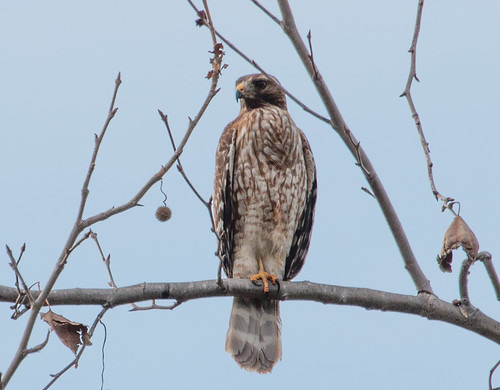
I didn’t hear or see another Pileated all that day. A female showed up the next day and has been coming a few times a day ever since, even working on excavating a cavity in the box elder next to my window.
But I didn’t get a glimpse at a male Pileated—not the banded male I call BB nor the one I call “NotBB”, until “NotBB” showed up at first light today, December 12, when the temperature was -14º F. I watched vigilantly all morning and into the afternoon, but still no sign of BB.
Except for this morning, I’ve of course not been looking out the windows constantly, and Saturday the 7th, I got sick from Covid—I don’t think I looked out the window once all day, and I was too sick to spend even a moment at my desk from then until Wednesday the 11th. But during that time, just passing the kitchen or dining room window or letting Pip out, I’ve seen the female Pileated every day.
This is the longest I’ve ever gone without seeing BB or, when I’ve been out of town, at least hearing from Russ or Tom that he’s been here since I first noticed that I had a banded Pileated on November 3, 2021, except during the weeks when BB was nesting somewhere else in the neighborhood in 2023. I knew for certain that he’d been nesting when he started bringing his babies here. What a thrill that was!
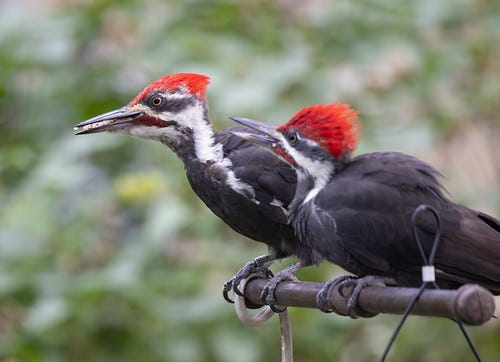
It’s frustrating not knowing what happened, but the Cooper’s Hawk is definitely implicated. Females can weigh double what the heaviest Pileated Woodpecker weighs (12 ounces). Even dainty little Sharp-shinned Hawks, with the heaviest females lighter than the lightest Pileateds (about 8 ounces), can pose a real threat to them—I watched one female sharpie dive-bomb, over and over, one of my female Pileateds back in November 2018.
That sharpie finally gave up. An equally determined Cooper’s Hawk, bigger, faster, and stronger, could have nabbed the woodpecker much more easily.
That said, it’s not yet time to start mourning. BB may have disappeared not because he was killed but because a close call scared him off to another part of the neighborhood for a while. He was banded at Hawk Ridge as a first-year bird in 2020, and he’s lived in this neighborhood right under the Ridge ever since, meaning he’s survived along a major raptor migration route for four spring and five autumn migrations, so he’s hardly inexperienced with raptors. But unless I see or get word of a live or dead male Pileated Woodpecker with a band on his right leg, I’ll never know for sure.
I don’t usually get to know individual birds as well as I’ve come to know BB, but on April 18, 2014, I noticed a chickadee with a deformed bill at my feeder. I started feeding it live mealworms, and it did well, but did not raise a family that year. Chickadees select mates who have the best chance of helping them rear healthy babies, and with the bill so overgrown during the winter when chickadees pair up, this one was left alone.
At some point that spring, the overgrown tips of the bill broke off, and little by little the bill became so normal looking that I would have never been able to recognize this bird as an individual anymore, except that while the broken bill was still a little recognizable, I noticed that this chickadee had another deformity as well—it was missing all the front toes on its right foot. I looked through all the photos I’d taken of it while the bill was terribly overgrown, and yep—in every one where the right foot was visible, the toes were missing.
I looked out for the little thing throughout the summer, autumn, and following winter. The bill was apparently entirely repaired—chickadees hammer their beak into trees to make cavities, and hammer into sunflower seeds and other hard shells for food, so that kept the bill in good shape. I got very busy that spring and stopped paying close attention. When May came around, my neighbor Jeanne Tonkin, who lives kitty corner from me, spotted the chickadee with a mate, and then the two birds came to my window together, giving me at long last a proper pronoun for him, because he was feeding her.
Jeanne called me on June 10 to tell me that the pair was nesting in her yard in what appeared to be an abandoned Downy Woodpecker cavity in a dead cherry tree. I rushed right over and got a bunch of photos.
The young seemed close to fledging, so I went over there first thing the next morning. It was lucky I did—at least two or three babies had already fledged!
I could hear and see the parents attending to them up in the trees—but fortunately, two were still in the cavity and I got to watch them take flight.
Too bad I didn’t anticipate seeing this or I’d have brought my tripod!
That splendid morning was the last time I ever saw that wonderful individual chickadee I’d grown so attached to. And that was the perfect happily-ever-after ending. He well may have joined up with his mate’s winter flock that year, so there’s reason to believe he really did live long and prosper.
If November 30 was the last time I’ll ever see BB, it’s not such a fairytale ending. As I said, he well may be hiding out elsewhere in Lakeside, but I know he appreciates my suet feeders. This morning when it was 14 below, he didn’t stop by even for a moment.
If at year’s end I still haven’t seen him, I’ll send a report to the Bird Banding Laboratory for the last date I saw him, November 30, 2024, noting that he was alive. Four and a half years old, BB’s known age, is nowhere close to the longevity record for Pileated Woodpeckers—the Bird Banding Website lists one New York male surviving 9 years and a Maryland male surviving a minimum of 12 years 11 months.
That’s a record I wanted BB to break. For three full years, I’ve not once been able to see a male Pileated Woodpecker here without searching for a band on his right leg. That’s a habit I’m not likely to break anytime soon. I’ll post immediately if I spot it.


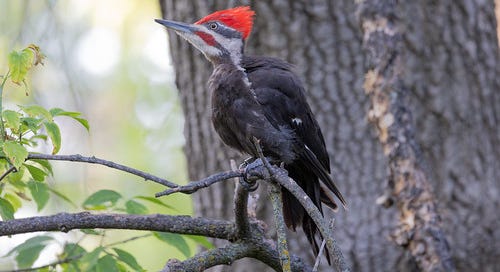



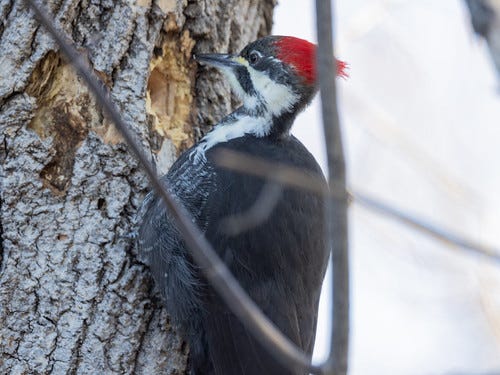
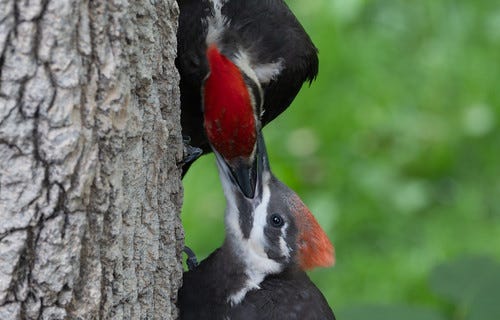
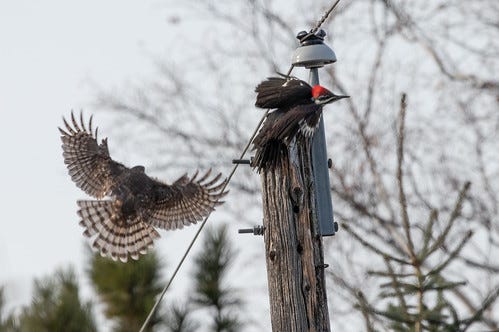



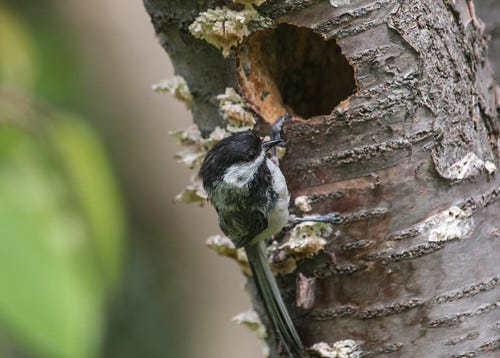
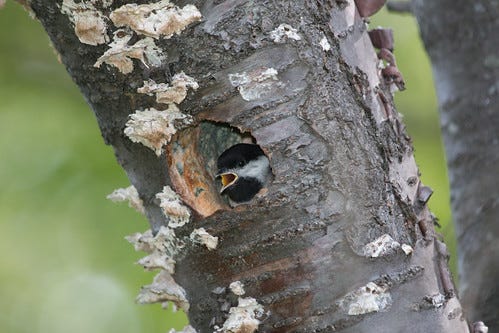



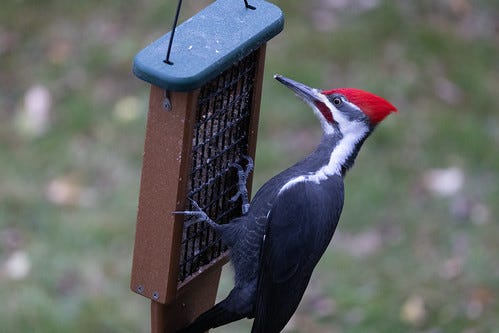
Keep the positive attitude that BB will show up. I’ve only had one pileated many years ago. He followed me when I walked outside one tree behind me all the time. I would so love to see another.
I hear your concern for BB and know darn well it's valid, of course. Cooper’s, now in the Asturnia genus, are know woodpecker hunters when attacking and consuming larger prey (ie larger biomass) is more efficient in colder weather, as you point out. My subscription to the Birds of the World life histories has temporarily lapsed, and I haven't the print species account anymore, but John Kenneth Terres's The Audubon Society Encyclopedia of North American Birds says they adore flickers, other woodpeckers, meadowlarks, young pheasants, and other like medium-sized prey items, including rabbits when they more rarely take mammals (but are more likely to do so than "sharpies").
Back when falconry was unregulated during the Great Depression, my father Fred was a teenage hawker with a female Cooper's Hawk, a species no longer used because they're nasty. It took two crows "simulataneously", probably one after another, but who knows, in the air at the famous Flourtown meet in 1940 when my Dad was 14 years old. Scary. He had a scar where she put a talon straight through his palm.
He decried falconry after that as cruel, abusive, and underegulated and chose to go hawkwatching instead on Pennsylvania's Kittatinny Ridge, an appreciative preference for wild raptors that I inherited and enjoy today. For one thing, his family had Gyrfalcons, "Northern" or American Goshawks, and Peregrine Falcons, all future threatened species, the goshawk being extremely endangered and possibly extinct here in PA now as a breeder. (Hawk Mountain and the state are working on that, it being a difficult bird to find). Grandad, Uncle Tibby, and Dad used to go to the Hudson River Palisades in New York City in their Model T to take peregrine eyases to raise and train, food acquisition during the Depression being half the reason. They eventually had four peregrines that way. I checked the records in Bill Hickey's Peregrine Falcon recovery book in Muhlenberg College's library and the final year of eyas-taking in the 30's that led to the palisade extirpation that decade was exactly 4. Worse, other falconers took the eggs. Thus the need at least for regulation! Falconers eventually weren't the main threat, a position taken by DDT, and played an integral role in recovery with their knowledge of remaining eiries to obtain stock for the captive-breeding program by Tom Cade, though I believe, sounding the first alarm about DDT, too, was Hickey's idea. Hickey, being Aldo Leopold's successor at the University of Wisconsin, of course, I believe possibly being an old haunt of yours maybe...(?).